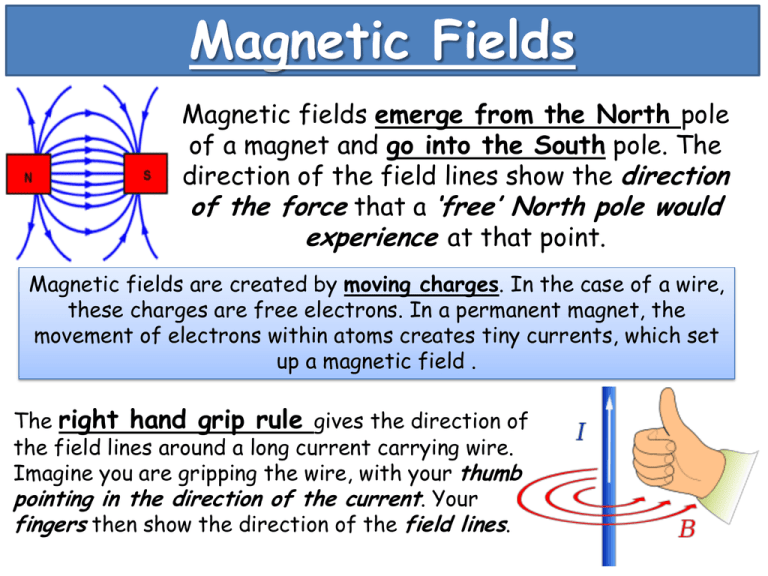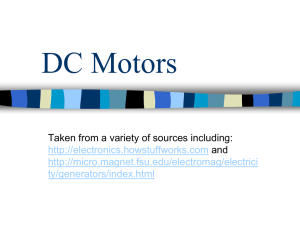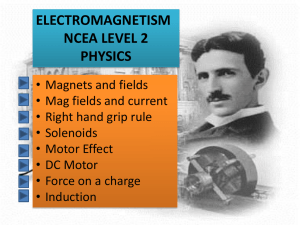Magnetic Fields
advertisement

Magnetic Fields Magnetic fields emerge from the North pole of a magnet and go into the South pole. The direction of the field lines show the direction of the force that a ‘free’ North pole would experience at that point. Magnetic fields are created by moving charges. In the case of a wire, these charges are free electrons. In a permanent magnet, the movement of electrons within atoms creates tiny currents, which set up a magnetic field . The right hand grip rule gives the direction of the field lines around a long current carrying wire. Imagine you are gripping the wire, with your thumb pointing in the direction of the current. Your fingers then show the direction of the field lines. An electromagnet makes use of the magnetic field created by a current. One end becomes a North pole, where the field lines emerge from, and one end becomes a South pole. To identify the poles, look at it end on and decide which way the current is flowing: Current anticlockwise = North pole Current clockwise = South pole Magnetic force A current carrying wire is surrounded by a magnetic field. The magnetic field of the current carrying wire can interact with the external magnetic field of the permanent magnet. The wire will move, showing that a force is acting on it. Fleming’s left Hand Motor Rule predicts the direction of the force on the current carrying conductor. The motion, field and current are mutually perpendicular. The ‘strength’ of a magnetic field is magnetic flux density, B. This can be imagined as the number of field lines passing through a region per unit area. The magnetic flux density is greatest when closest to the poles of the bar magnet. It gets smaller as you move further away. Magnetic flux density is measured in tesla. The tesla can be defined: To define magnetic flux density: 𝑭 𝑩= 𝑰𝑳 F = force (N) B = magnetic flux density (T) I = current (A) L = length of conductor perpendicular to field (m) Mutually perpendicular The magnetic flux density is one tesla when a wire carrying current of 1A placed at right angles to the magnetic field experiences a force of 1N per metre of its length. So, the size of the force on a current carrying wire perpendicular to a magnetic field is proportional to the current, the length of wire and the magnetic flux density : F= BIL. If however the wire is at an angle other than 90°: F = BIL sinθ The force is greatest when the wire and the field are perpendicular to each other (because sin 90 is 1, so this is where the component of the magnetic field perpendicular to the current is the greatest) where θ is the angle between the magnetic field and the current or conductor. The force is 0 when the magnetic field and the current are parallel (because sin 0 is 0) Magnetic Forces on Moving Charges 𝑭 = 𝑩𝑸𝒗 The force on a moving charge is determined by the magnetic flux density, B, the charge, Q, and the velocity of the particle, v. The force F is always at right angles to the particle’s velocity, v, and its direction can be found using Fleming’s left hand rule. For a charged particle moving in a circle, the BQv force acts as a centripetal force. We can use this to calculate the radius of an orbit of a charged particle in a magnetic field: 𝑚𝑣 2 𝑟 = 𝐵𝑄𝑣 hence 𝑚𝑣 =𝑟 𝐵𝑄 This equation shows that: Faster moving particles move in bigger circles – velocity is directly proportional to radius Particles with a larger mass move in bigger circles – mass is directly proportional to radius A stronger field will cause particles to move in a smaller, tighter circle – magnetic flux density is inversely proportional to radius. A deflection tube is designed to show a beam of electrons passing through a combination of electric and magnetic fields. By adjusting the strength of these fields, you can balance the forces on the electrons so that the beam remains horizontal. An electron had charge –e, and an amount of work QV is done when accelerating it from cathode to anode. This work is equal to its kinetic energy. We therefore have: 𝟏 eV = m𝒗𝟐 𝟐 If the electron beam remains straight, the electric force must be equal to the magnetic force: EQ = BQv E = Bv 𝑬 𝒗= 𝑩 Mass Spectrometers A mass spectrometer allow the masses of ions to be found with greater accuracy – enough to determine the empirical formula – as well as the relative abundances of each ion. A mass spectrometer gives molecules a positive charge of +e in the ion source, where they are then accelerated through a voltage V. They then pass through a strong magnetic field. The speed of the particles can be determined by the ‘velocity selector’. The velocity of a particle v is E/B, so by changing the magnetic field strength and electric field strength, particles of a particular velocity can be chosen. The ions of heavier molecules are deflected less than lighter ones – the radius gets larger as m gets larger. Only ions travelling at a particular radius can pass through the slit and into the detector. The detector is connected to a computer which identifies the ions from their mass to charge ratio and records the amount of each ion.







